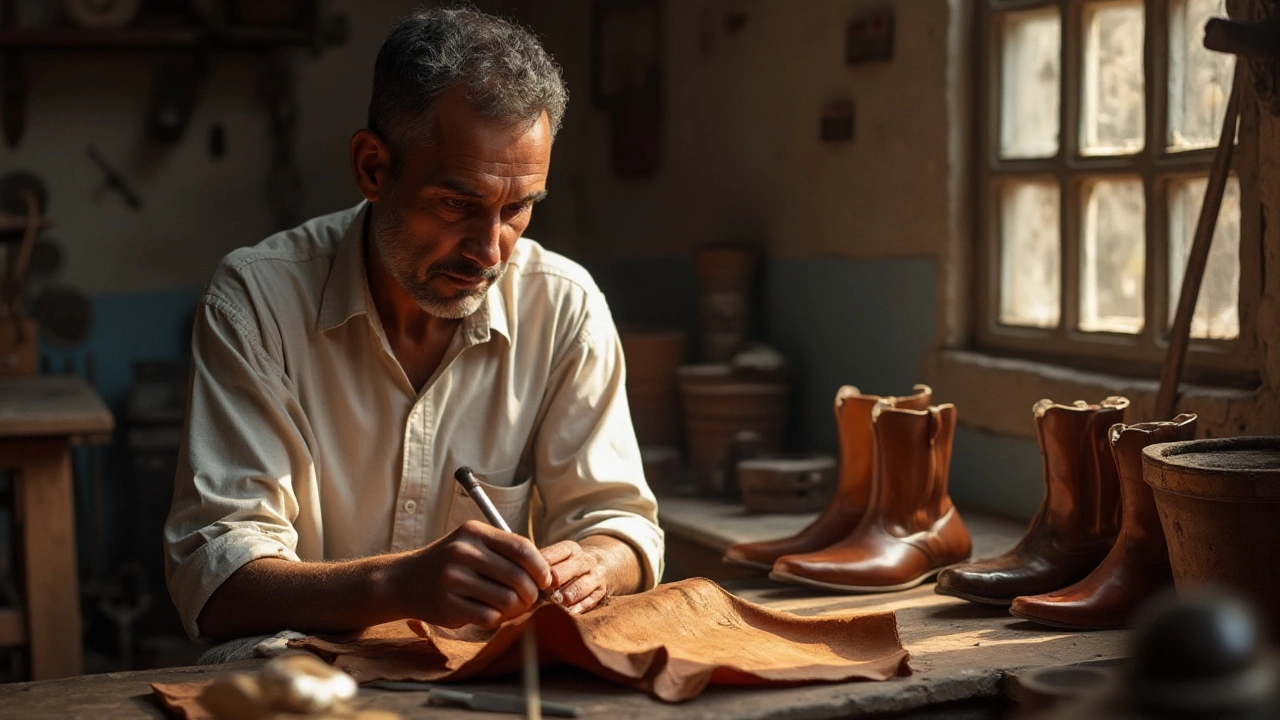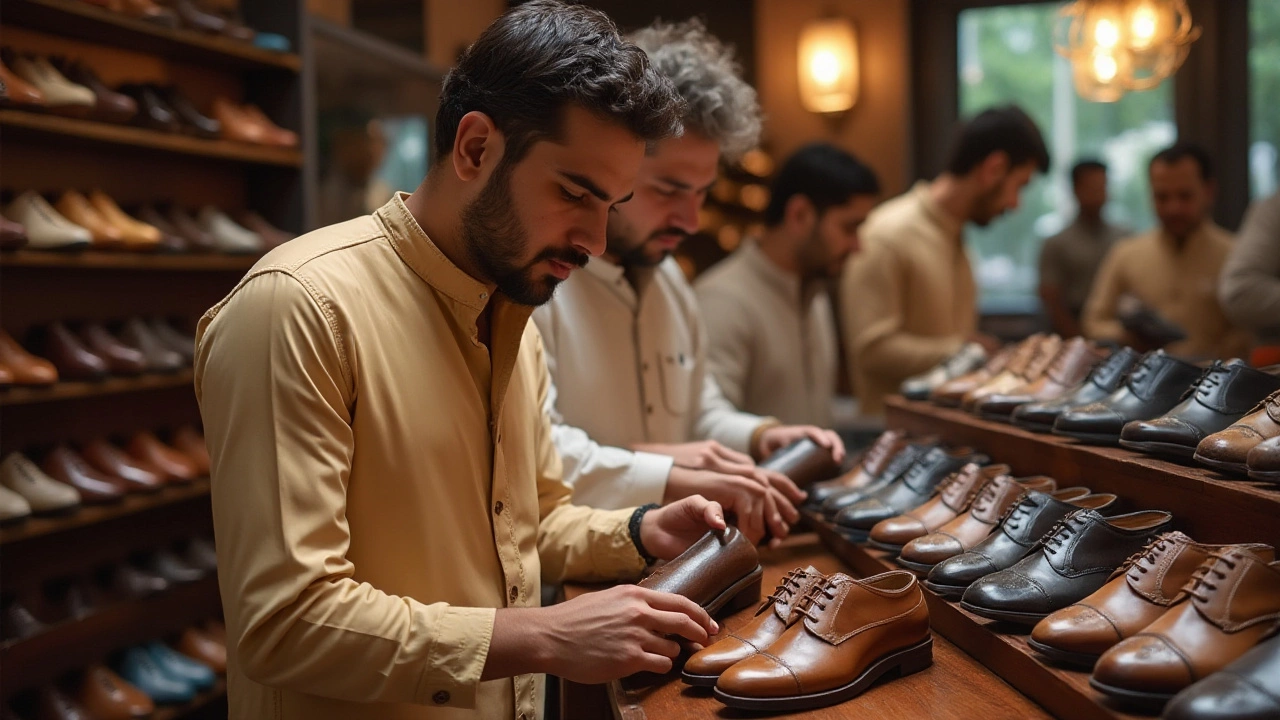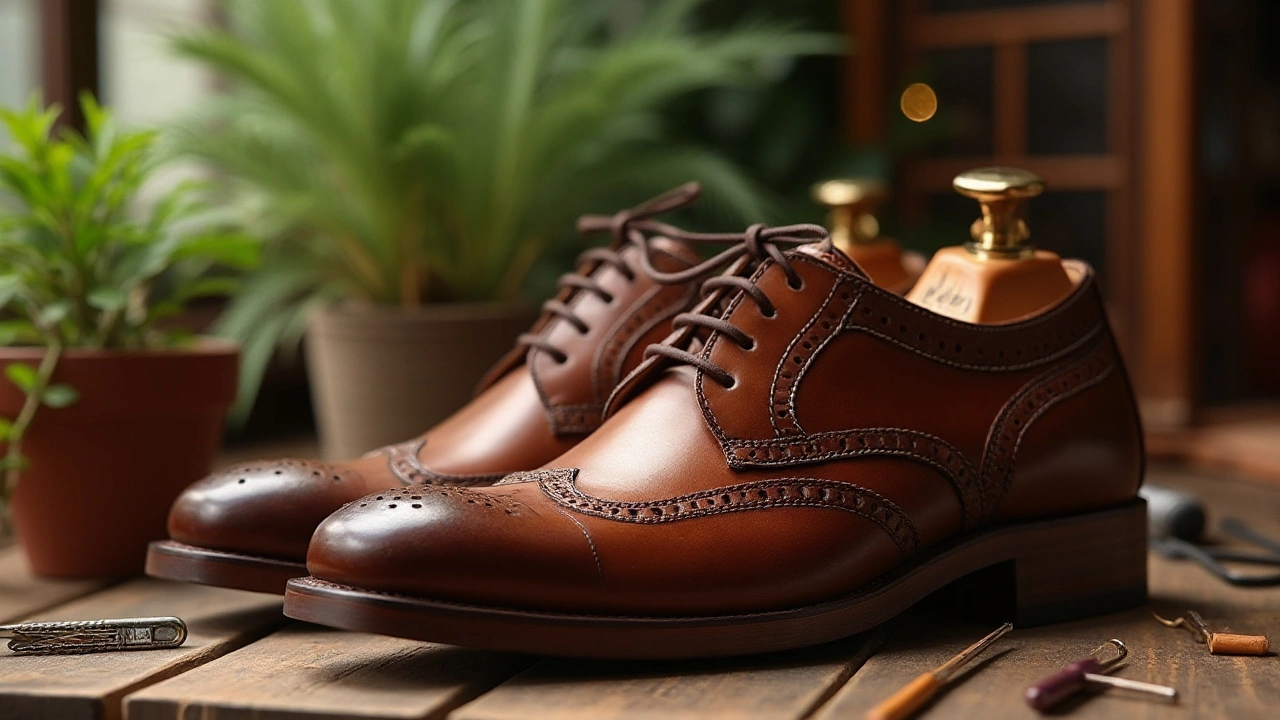Identifying Quality Leather Shoes: A Comprehensive Guide

Investing in a pair of leather shoes can be rewarding, but not all leather footwear is created equal. Quality varies widely, and distinguishing the well-made pairs from the less durable can impact your satisfaction. Navigating this realm requires a keen eye and some insider knowledge.
Whether you're a seasoned leather shoe enthusiast or a newcomer eager to step into luxury, understanding what sets apart the premium from the ordinary can guide you towards a wise purchase. From the type of leather to the way it's put together, every detail counts in making the perfect pair. In this guide, we uncover these secrets to help you find shoes that not only fit your feet but also echo your style and serve you well over time.
- Understanding Leather Types
- Examining Shoe Construction
- Checking Stitching and Finishing
- Assessing Comfort and Fit
- Recognizing Quality Brands
- Caring for Your Leather Shoes
Understanding Leather Types
Before stepping into the elegant world of leather shoes, it's essential to gain a solid grasp on the different types of leather available. Leather is not just about the look; it's about the feel, durability, and story behind each hide. One common type is full-grain leather. Known for its strength and suppleness, full-grain retains the complete grain of the hide, which means it's not sanded or buffed to remove imperfections. The beauty of full-grain leather is its natural texture and the way it develops a rich patina over time. This characteristic not only adds to the shoe’s aesthetic value but also narrates the journey of the leather itself.
On the other hand, there is top-grain leather, which is often confused with full-grain. While top-grain is still of high quality, it undergoes a sanding process to eliminate surface imperfections, and a finishing coat is applied. This makes it slightly less durable but gives it a more uniform appearance, often preferred for its polished look. Another leather type that enthusiasts might encounter is genuine leather. This term can be somewhat misleading, as "genuine" doesn't necessarily imply top-tier quality. It refers to the leather surface that's been stripped down to the lower layers. Though more affordable, genuine leather lacks the durability and character of full- or top-grain varieties.
Additionally, while exploring leather shoes, you may come across nubuck and suede. Both are made from the underside of the hide, with nubuck being sanded on the outside, giving it a velvet-like touch. Suede is similar but tends to be softer and more pliable, often used for styles that require a gentle finish. However, both demand careful maintenance since they're more susceptible to water and stains. Interestingly, a study in the Journal of Leather Technology emphasized that full-grain and vegetable-tanned leathers have significantly higher tensile strength compared to other leathers. Such insights guide buyers interested in sustainability and long-lasting elegance.
For those who value ethical and environmental concerns, vegetable-tanned leather is a notable choice. Unlike using synthetic chemicals, this process utilizes natural tannins from plants, offering an eco-friendlier method that harks back to ancient tanning techniques. Leather shoes made from vegetable-tanned hides possess unique hues and eventually darken over time, creating a distinctive look with wear. As a celebrated leather craftsman once remarked, "Good leather is like wine; it only gets better with age."
Choosing the right type of leather isn’t just a matter of preference but also understanding lifestyle and care willingness. A polished connoisseur's cabinet might favor full-grain for its robust narrative, while urban dwellers might lean toward top-grain for its sleek appearance. As awareness grows, investing in high-quality leather shoes demands not just an eye for elegance but knowledge that paves the way for informed decisions and deeper appreciation for the craft of shoemaking itself.
Examining Shoe Construction
When it comes to evaluating the construction of leather shoes, you're essentially looking into the soul of the shoe. This is where craftsmanship and quality meet to create a product that can either stand the test of time or fall apart at the seams. One pivotal aspect to examine is the method used to attach the sole to the upper. Among the most esteemed techniques is the Goodyear welt, known for its durability and ease of repair. This method involves a strip of leather, the welt, sewn around the bottom edge of the shoe. This not only enhances durability but also allows for resoling, significantly extending the shoe's life span.
Another key construction element to be aware of is the type of stitching used. High-quality shoes often feature a tighter stitch density, which means more stitches per inch. This increases the shoe's resilience against wear and tear. Look closely at the seams; they should be even and precise, with no loose threads or visible glue marks. The attention to detail here is not just aesthetic, but indicative of a shoe that will hold up under regular use.
Within the realm of shoe construction, an often-overlooked factor is the insole material. A flexible, leather-lined insole not only adds comfort but also allows the shoe to mold to the wearer’s foot over time. This personalization is crucial for both comfort and longevity, ensuring that the shoe adapts uniquely to your form. In contrast, shoes with cardboard insoles can deteriorate swiftly, leading to discomfort and less wearability.
Paying attention to the construction also involves understanding the importance of heel fabrication. A well-crafted heel is typically stacked, meaning several layers of high-grade leather are bound together. This aids in balancing the weight of the shoe, distributing pressure evenly across the foot, and enhancing stability during movement. On occasion, manufacturers may introduce synthetic materials that mimic the look of stacked leather, but they often lack the same durability.
"The art of shoemaking is one of the most traditional crafts, and its importance is not lost on those who seek both aesthetic and functional quality," says James Taylor, a renowned shoemaker from Northampton, England.
Paying attention to the finer details, such as eyelets for laces, can also shed light on craftsmanship. Metal eyelets tend to resist wear better than their fabric counterparts. Similarly, the finishing of the leather - whether polished, dyed, or textured - can reveal the level of care and attention a manufacturer invests in their product. Ultimately, each of these construction aspects contributes to the integrity of the shoe, ensuring that you're not just investing in style, but in a piece that will serve diligently over time.

Checking Stitching and Finishing
When it comes to identifying high-quality leather shoes, stitching and finishing are two key elements that should never be overlooked. The craftsmanship involved in the stitching process can reveal much about the shoe's durability and aesthetic appeal. Shoes that boast precise, even stitches are typically emblematic of meticulous construction. Ideally, the stitches should be strong yet unobtrusive, enhancing the shoe's design without overshadowing it. Examine closely for any missed stitches or loose threads, as these are clear indicators of inferior craftsmanship.
The type of stitching also plays a critical role. For instance, Goodyear welted shoes, known for their durability and comfort, feature an additional layer between the soles and uppers, making them more resistant to water and wear. This method, often seen in high-end shoes, signifies quality construction that stands the test of time. As an insightful comment from leather experts goes, "The Goodyear welt is akin to a seal of quality in leather footwear."
Beyond stitching, the finishing process seals the deal on quality. A polished finish not only elevates the shoe's appearance but also its longevity. Look for consistency in color and texture, which suggests that the shoe has been carefully finished and treated. Irregularities such as scuffs or uneven colors can signal a hasty production process. People often miss these tiny details, but they are crucial to ensure that the shoes you choose will serve you well for years. Checking the sole attachment is another critical aspect; a firm bond between the sole and the upper is essential for a shoe's structural integrity.
The attention to the shoe's lining and insoles also contributes to its finish. Soft, high-quality leather linings add comfort and help the shoe maintain its shape. Quality insoles, with supportive cushioning, reflect thoughtful design geared towards your foot's needs. These elements may seem ancillary, but together they enhance your experience with the shoes. With a bit of practice, these quality indicators become easier to spot during your next shoe shopping expedition, leading you to the best leather shoes for your collection.
Assessing Comfort and Fit
When it comes to leather footwear, finding the right comfort and fit is a cornerstone of quality. The journey begins with understanding how the shoe aligns with the natural contours of your foot. Properly fitting leather shoes should complement the foot's shape, offering a snug, yet not constricting, embrace. A well-made shoe cradles the arch and provides just the right amount of room at the toe box, allowing your toes to splay comfortably as they do when barefoot. Contrast this with poorly fitting shoes, which often lead to discomfort, pinching, and even pain over time.
The type of leather plays a pivotal role in comfort, as some leathers, like calfskin, are renowned for their softness and ability to mold to the foot. The process by which the leather is tanned can also affect this flexibility. The tanning method should enhance the leather's breathability, which is crucial for foot health and comfort, preventing the development of unpleasant odors and blisters. Pay attention to cushioning and support provided by the insole, as this component can make a significant difference in how the shoe feels over extended periods of wear.
Shoe buying guides often suggest trying on shoes in the afternoon, as feet naturally expand throughout the day. When trying on shoes, it is essential to walk on different surfaces to gauge how the movement feels. Listen to your body; if something feels off, it probably is. Flex your foot and notice any tight spots or if the heel slips. A shoe that fits well should not require extensive breaking in; it should feel supportive yet allowing for natural movement from the onset. Leather can naturally stretch, but resist choosing a tighter fit with the expectation that it will adjust perfectly. If the shoe has laces or adjustable closures, use them to fine-tune the fit before deciding if it truly feels right.
According to a study by the Arthritis Foundation, wearing well-fitting shoes can reduce joint pain and support overall foot health.
"Your shoes should be the most comfortable clothing you own," says Dr. Jane Andersen, a podiatrist with extensive experience in foot comfort research. Her advice underscores the significance of comfort in footwear, which directly impacts your everyday life and health.In essence, the marriage between style and function in leather shoes comes down to how they accommodate your unique anatomy. With the right attention to detail, every step you take in a beautiful pair of leather shoes can become an expression of comfort and confidence.
| Aspect | What to Check |
|---|---|
| Arch Support | Should complement the foot's curve |
| Toe Box | Adequate room for toe splay |
| Heel Fit | Secure without slipping |

Recognizing Quality Brands
In the world of leather shoes, the brand can often serve as a reliable signal of quality, craftsmanship, and style. Many well-established brands have built their reputation over decades, sometimes even centuries, by consistently delivering exceptional products. To recognize a reputable brand, one must consider the history, ethos, and customer reputation of the company. A brand’s commitment to quality is often reflected in its sourcing of materials, the skill of its artisans, and the durability and comfort of its shoes.
Brands such as Allen Edmonds, for instance, are renowned for their commitment to American craftsmanship. The company has been a staple in the shoe industry since 1922, known for its use of full-grain leather and meticulous construction methods, including the celebrated Goodyear welt. Such methods not only ensure durability but also allow the shoes to be resoled, expanding their lifespan significantly. Similarly, brands like John Lobb and Church’s from the UK have made their mark by offering timeless designs and unparalleled attention to detail.
Quality brands are not solely about aesthetics; they often emphasize sustainable practices and fair trade. Brands like R.M. Williams emphasize the importance of supporting local artisans while sourcing sustainable leather, thereby delivering shoes that are not just high in quality but ethical in production. As consumers become more eco-conscious, these values are becoming key selling points. A quote from a design director at a notable footwear company famously said, "A quality shoe respects the foot and the environment it walks on." This philosophy is echoed by brands that focus on sustainability without compromising on the quality.
When considering a quality leather shoe brand, it’s also beneficial to read customer reviews and testimonials, as these can provide insights into the real-world performance and comfort of the shoes. Long-standing loyalty amongst customers is often a good indicator of consistent quality, as satisfied customers will frequently return to a brand they trust. Some companies have even structured their marketing strategy by relying heavily on word-of-mouth, a sign of confidence in the quality they deliver. Expert recommendations, found in style magazines or online platforms, can also guide you towards the best brands that combine innovation with tradition.
Moreover, it’s helpful to attend shoe fairs and exhibitions, where many top brands showcase their latest collections. Such events provide an opportunity to not only inspect the shoes up close but also engage with representatives from the brands. Through these interactions, you can gain insights into the ethos of the brand and their dedication to quality. Knowledge about quality brands helps in making informed decisions, ensuring that when you invest in a pair of leather shoes, you're purchasing not just footwear but also a part of heritage and tradition that will stand the test of time.
Caring for Your Leather Shoes
Caring for your leather shoes is not just about keeping them clean; it's about preserving their quality and extending their lifespan. The first step is to ensure they are stored correctly. Use a shoe tree, preferably cedar, as it helps maintain the shoe's shape and absorbs moisture from the leather. Leather is a natural material that reacts to its environment, and keeping shoes in a stable, room-temperature atmosphere is vital. Avoid storing them in plastic, as the lack of air circulation can lead to mildew and a discouraging odor over time.
Cleaning your shoes is equally critical. Start with a soft, dry brush to remove any surface dirt or debris. Always clean leather shoes after use, especially if they've been exposed to mud or road salt. These substances can be detrimental if left on the leather. Use a dedicated leather cleaner or a damp cloth for tougher spots. If they get wet, let them air dry naturally away from heat sources. Heat can cause the leather to dry out too quickly, leading to cracks which are difficult to repair.
Conditioning leather shoes regularly ensures they remain supple and retain their vibrant appearance. Leather conditioner works to replenish the natural oils that the leather loses over time. Apply a small quantity with a clean cloth and rub it evenly over the surface in circular motions. Always test new conditioners on a hidden part of the shoe to ensure compatibility. Conditioning should be done more frequently in dryer climates, as the air itself can pull moisture from the leather. According to renowned leather expert Hugo Jacobs, "A well-conditioned shoe can last a lifetime, reflecting the care put into maintaining its elegance."
Caring for leather shoes is akin to nurturing a fine wine; it's an art as much as it is maintenance.
Polishing is another key component. Choose a polishing cream or wax that matches the shoe color. Regular polishing not only revives the color but also adds a layer of protection against the elements. Apply the polish using a soft cloth, and work it into the leather through gentle, even strokes. Allow it to dry, and then buff with a separate cloth to achieve that classic sheen. For added protection, consider applying a waterproofing spray, especially if you're anticipating wet weather.
Finally, refresh your shoes by occasionally letting them rest. Alternate between pairs if possible. Constant wear without breaks can lead to accelerated wear and tear. A rest period, with the use of shoe trees, allows leather to breathe and return to its natural state. Embrace the ritual of caring for your leather shoes; it transforms into a rewarding routine that celebrates craftsmanship and style.
- Jan, 10 2025
- Violet Greenfield
- 0
- Permalink
Written by Violet Greenfield
View all posts by: Violet Greenfield